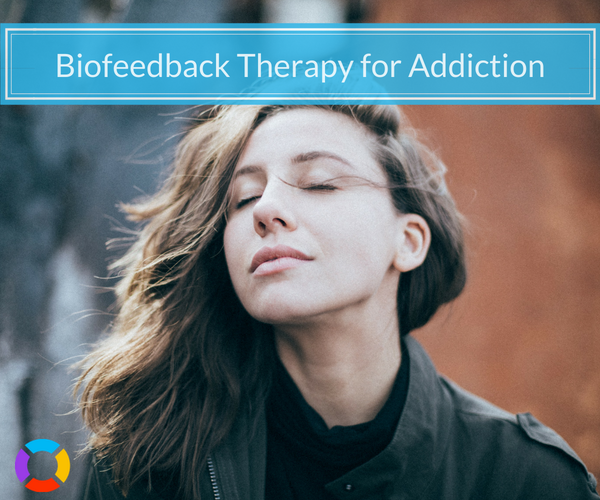Biofeedback Therapy for Addiction Explained + Free Recovery Workbook

Biofeedback therapy for addiction treatment is a holistic approach to relapse prevention that trains your awareness of physiological cues to stress. Biofeedback is a mind body connection therapy that teaches you how to reduce the physical symptoms of stress through behavioral, emotional and cognitive self regulation.
Biofeedback for addiction helps control cravings when you’re in recovery, reducing the risk of relapse.
Several types of biofeedback techniques provide immediate feedback to the user. Neurofeedback uses functional magnetic resonance imaging (fMRI) or electroencephalography (EEG) to measure electrical activity in the brain. Thermal feedback measures body temperature through infrared sensor equipment.
Heart rate variability (HRV) is a technique that uses a pulse meter or an electrocardiogram to track rises and falls of heartbeats.
Biofeedback therapy was once considered unconventional in addiction treatment. Now, with research supporting its efficacy and positive outcomes in maintaining long term sobriety, many rehab facilities employ specialists trained in biofeedback techniques.
Download our Biofeedback Relaxation Exercises Guide and start practicing techniques you can use anytime, anywhere.
What Is Biofeedback Therapy?
Biofeedback therapy focuses on the physical responses you have to stressors such as substance cravings, detox symptoms and impulsive responses to stimuli.
It is used in the treatment of other mental or medical health conditions such as depression, anxiety, ADHD, incontinence and diabetes, helping you to gain conscious control over physiological responses.
By developing awareness of your heart racing, temperature rising and your mind’s obsessive cycling, you can learn to reduce physical symptoms and redirect your actions.
Biofeedback therapy techniques teach you how to use meditation, breathing exercises and changing thought or breathing patterns to reduce stress. Current research has demonstrated that biofeedback reduces impulsivity in addiction treatment, reducing relapse risk.
Curious about biofeedback therapy? Call today for help.
How Biofeedback Helps in Addiction Recovery?
Biofeedback for addiction is a therapeutic approach that teaches you how to recognize and regulate your body’s physical responses, such as heart rate, breathing and muscle tension.
This method provides you with valuable insight into how stress and cravings affect your recovery. By learning self control, you can build healthier coping strategies that support long term sobriety.
Does Biofeedback Therapy Work for Addiction?
Yes, biofeedback is an evidenced based therapy with research that supports its use in addiction treatment. It helps you gain awareness and control over physiological responses, which can reduce cravings and support long term recovery.
How Does Biofeedback Prevent Relapse?
Biofeedback helps to prevent relapse by training a person to become aware of their physical responses to triggers and cravings. By being able to recognize the body responses, emotion and behavior can be applied to prevent impulsive responses.
Types of Biofeedback Therapy Used in Addiction Treatment
Several types of biofeedback therapy techniques are used to support addiction treatment, each targeting different physiological functions. These methods help you understand how your body responds to stress and cravings, giving you practical tools to manage triggers and maintain recovery.
Neurofeedback
Neurofeedback addiction treatment is one of the most common biofeedback therapies used in addiction recovery. By training the brain to regulate, it helps reduce cravings and reactivity to triggers, supporting long term sobriety.
- Neurofeedback is the most frequently used type of biofeedback in addiction treatment, commonly used in alcohol use disorder and demonstrating reduction in symptoms and sustainable long term sobriety. It has also been used to reduce nicotine and cocaine addiction.
- Your brain is essentially an electromagnetic system that produces electric charges. These charges form pathways, connecting through synaptic nodes. These nodes are the centers for thought, memory, behavior and emotion.
- It measures brain wave frequency, the relationship between brain waves, the speed of brain activity and measures the level of brain wave intensity
- Neurofeedback recognizes how your brain functions and then helps it form new pathways, reducing the power of impulsivity caused by cravings and reactivity to triggers.
- New pathways help change thoughts and feelings by recognizing how the stimulus or triggers activate the brain activity, thus reducing relapse potential.
Thermal Biofeedback
Thermal biofeedback focuses on measuring skin temperature to reveal how your body responds to stress, relaxation and emotional triggers. In addiction treatment, it helps you recognize physical signs of tension and practice techniques that promote calmness, reducing the likelihood of relapse.
- Thermal biofeedback commonly uses digital infrared thermal imaging (DITI). It is a noninvasive way of measuring body temperature without radiation.
- During biofeedback training, temperature mapping trains you to be aware of how your body heat levels fluctuate during stressful situations, such as exposure triggers and cravings for substances.
- You learn various interventions to relax and reduce the heat intensity.
Medical applications also use thermal mapping to measure inflammation and in mental health applications such as obsessive compulsive disorder.
Thermal biofeedback can be combined with EEG or fMRI neurofeedback to improve your awareness of physiological responses to stressors. Research indicates success when thermal biofeedback is used for nicotine addiction, reducing cravings and other impulses.
Electromyography (EMG)
Electromyography (EMG) measures muscle tension and helps you become aware of what triggers that tension.
By learning how to relax in response, you can reduce cravings and impulsive reactions to your triggers. EMG training is often combined with neurofeedback and thermal biofeedback, allowing you to practice relaxation techniques in real time by intentionally tensing and releasing muscles.
Want to know more about biofeedback therapy? Speak to someone today.
Benefits of Biofeedback Therapy for Recovery
Research substantiates using biofeedback in combination with other behavior modification therapies to produce positive outcomes in the following areas. It empowers you to actively participate in your recovery by gaining control over both physical and emotional responses.
Reduces Cravings
Biofeedback helps retrain your body’s stress responses, making it easier to manage the physical and emotional cues that fuel cravings.
By learning to regulate these signals, you gain tools to stay focused and resilient during recovery.
- Lowers sensitivity to triggers
- Teaches self regulation of body and mind
- Supports early sobriety and long term recovery
Manages Withdrawal Stress
Biofeedback provides techniques to calm your body and mind during withdrawal, easing the discomfort that can make recovery feel overwhelming. By learning to regulate physiological responses, you can reduce stress and promote a more stable healing process.
- Calm the nervous system
- Reduces muscle tension
- Improves sleep quality
- Stabilizes heart rate and breathing
- Lowers anxiety linked to withdrawal
- Improves emotional regulation
- Promotes a sense of control and resilience
Helps Dual Diagnosis
Biofeedback is especially valuable when you have a dual diagnosis, such as anxiety, PTSD or depression, alongside addiction.
Teaching you to regulate stress responses and improve emotional balance supports your mental health management and recovery from substance use.
- Lowers anxiety levels
- Stabilizes mood swings
- Improves focus and concentration
- Reduces hyperarousal symptoms in PTSD
- Promotes relaxation and calmness
- Enhance coping strategies for daily stress
- Supports long term emotional resilience
Improves Long Term Relapse Prevention
Biofeedback equips you with practical skills to recognize and manage stress before it escalates into cravings or relapse. By reinforcing healthy coping mechanisms, you strengthen your ability to maintain sobriety over time.
- Build effective coping skills
- Strengthens stress tolerance
- Supports lasting recovery
- Encourages consistent self regulation
- Reduces vulnerability to triggers
- Promotes confidence in managing challenges independently
Want to try it at home? Our free Biofeedback Relaxation Exercises Guide walks you through step by step techniques used in recovery programs.
When to Use Biofeedback Therapy
During your detoxification process, biofeedback can help you learn to relax and ease the physical and emotional strain of withdrawal.
By monitoring and regulating functions such as heart rate, breathing and muscle tension, you gain tools to calm your body and mind in real time. This added support can make the detox process more manageable and set a stronger foundation for continued recovery.
During early treatment, biofeedback therapy can address trigger response training. Biofeedback techniques focus on building awareness and learning to relax.
It effectively helps you learn to respond differently to triggers rather than with impulsive relapse behavior. Early treatment often focuses on how to sleep, wake, eat and function in daily activities without substances. The process also helps you learn to navigate the newness of recovery.
In long term recovery for relapse prevention and maintenance, you have learned basic biofeedback skills. However, it is an ongoing process of learning relaxation techniques and continued awareness of triggers in response to stress. At home devices and computer programs can help you to invest in your long term recovery.
How Long Does Biofeedback Last?
A typical biofeedback training session lasts roughly 30 to 60 minutes, depending on your treatment plan and goals. You may require multiple sessions over several weeks to learn how to effectively recognize and control your body’s responses.
The exact length and number of sessions can vary based on your progress, the type of biofeedback used and the severity of your symptoms being addressed.
How Many Biofeedback Sessions are Needed?
The number of biofeedback sessions needed varies, but most people benefit from 10 to 20 sessions to see meaningful results. Some may require fewer or additional sessions depending on their condition, progress and treatment goals.
Is Biofeedback Safe?
Biofeedback therapy is a safe, noninvasive treatment with little to no risk of side effects. It is usually suitable for your treatment, though if you have complex conditions such as severe anxiety, PTSD or other dual diagnoses may need medical clearance to ensure it complements your overall treatment plan.
Where to Find Biofeedback Therapy for Addiction
Biofeedback therapy is offered in a variety of addiction treatment settings, ranging from standard rehabilitation programs to luxury inpatient rehab centers that provide more personalized amenities. Many facilities incorporate biofeedback into their recovery plans, either as a standalone service or in combination with other therapies.
You may get a referral through mental health providers, primary care physicians or addiction specialists. In some areas, community health programs or vouchers may be available to help cover the cost of biofeedback sessions, making this therapy more accessible when you are seeking support for addiction recovery.
Biofeedback Therapy FAQs
No, biofeedback should not replace medication used during the detox process. While it can help reduce anxiety and depression symptoms, you should always work with your provider before discontinuing medications.
Insurance coverage varies significantly, so call your insurance provider to verify your coverage or work with the admission staff at your treatment center of choice.
In network treatment providers or facilities may include biofeedback as part of the addiction treatment program, and costs are typically less than those from out of network providers.
Biofeedback is an ancillary therapy and should be used in combination with other treatments. It is not recommended as the only form of treatment in an addiction therapy program.
Once trained by a professional, at home monitors and computer programs can help build awareness of your physiological responses.
These devices measure thermal and EKG readings. Neurofeedback at home may be available using automated systems through telehealth.
Take the First Step in Recovery
Recovery begins by acknowledging that addiction is a problem and making the decision to seek help. This choice is never easy. Change requires learning healthier ways to cope with stress and approaching life differently.
While the process can feel overwhelming, support is available through treatment centers, insurance providers and even free programs in every state. Reaching out for help is the first step toward healing. It can open the door to a healthier, more hopeful future.
The ravages of addiction to substances destroy lives. You deserve to live a good life. Your life matters to others! Help is available when you are willing to reach out.
Biofeedback therapy can be a powerful tool in your recovery journey, but it works best when combined with professional detox and treatment. If you or a loved one is struggling, find a rehab center near you today.


